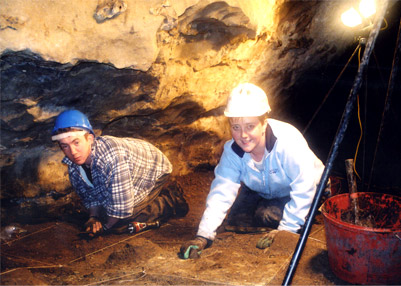A recent programme on RTE television “Blood of the Irish”, featured Dr Marion Dowd from the School of Science, at Institute of Technology Sligo, talking about the excavation of human remains in Glencurran Cave (the Burren) and analysis of ancient DNA. The two part television documentary programme explored the origins of the Irish.
It featured research which resulted from excavations carried out in Glencurran Cave that were led by Dr. Dowd, a leading expert on Irish cave archaeology, and a team of archaeologists. Skeletal remains of a 2-4 year old child that were placed in the cave in the Bronze Age (about 3,500 years ago) were subject to ancient DNA analysis. This is the first instance where ancient DNA has been successfully extracted from prehistoric human bone on the island of Ireland, and is cutting edge archaeological science.
Research excavations took place in the summers of 2004, 2005 and 2008 funded by the Department of the Environment Heritage and Local Government and latterly by the Royal Irish Academy. They revealed a unique site, unparalleled in Ireland or Britain, used in the Bronze Age as a place of ritual. It would appear that human bones and newborn animals (calves, lambs, piglets) and adult hares were deposited in the cave as some form of ritual offering. In addition to these were several Bronze Age pots, necklaces made from seashells and dog/wolf teeth and amber beads. In total about 60 human bones were recovered but these represent at least eight individuals – a newborn baby, two young children (2-4 years old) and five adults.
In most cases the bones seem to have been removed from burials outside the cave and brought in as disarticulated bone. However, one of the young children appears to have been a complete fleshed individual when placed in the cave. In 2007, in conjunction with Crossing the Line Films, a project was initiated in an attempt to see if ancient DNA could be extracted from one of the child’s bones. This type of scientific analysis is notoriously difficult because ancient DNA is degraded by the passage of time and also by fluctuating temperatures and standing water. Caves are relatively stable environments with little change in temperature or conditions, this seemed like an ideal environment from which to select a bone for DNA analysis. The bone was a fibula, a lower leg bone. It was sent to one of the foremost European DNA labs in the University of Mainz, Germany. After a few months good news was returned: the lab had successfully extracted ancient DNA. The bone was also radiocarbon dated and indicated that the child had been placed in the cave in the Middle Bronze Age, approximately 3,500 years ago.
The results are extremely exciting and important in terms of genetics, archaeological science and our understanding of early inhabitants of this island. This is the first time where DNA has been extracted from prehistoric human bone found in Ireland and is also the oldest DNA yet recorded on the island. The haplogroup (genetic family) of the child originated in Northern Europe approximately 52,000 to 45,000 years ago. This is the oldest Europe-specific haplogroup, known as U5. Further research was undertaken to establish whether that genetic signature was represented in modern populations living in the Burren today. DNA samples were taken from 13 school children living in the vicinity of the cave and remarkably, 3 of these showed a strong genetic link with the 3,500 year old child.

Further excavations and research are to take place at the cave in Summer 2009.
For further information contact:
Dr. Marion Dowd,
Lecturer in Prehistoric Archaeology,
School of Science,
Institute of Technology Sligo,
Sligo.
Email: dowd.marion@nullitsligo.ie
Phone: + 353 71 9155255